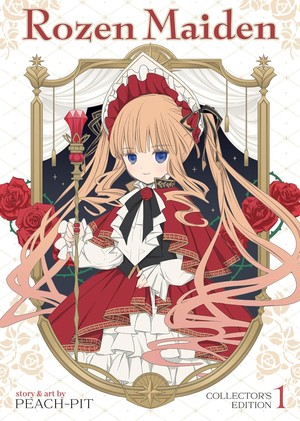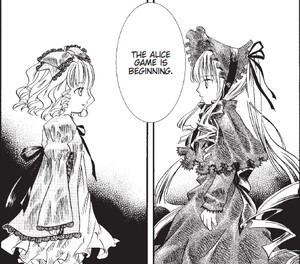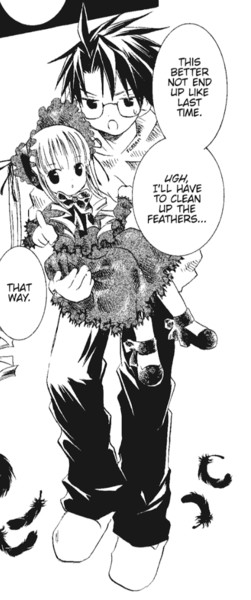The Spring 2025 Manga Guide
Rozen Maiden Collector's Edition
What's It About?

Now sworn to Shinku, Jun is pulled into the dangerous world of "The Alice Game," a deadly battle where only one of the seven Rozen Maiden dolls can emerge as the perfect doll. With danger lurking at every turn and Shinku's high-maintenance personality to contend with, Jun is about to learn just how intense playing with dolls can be!
Rozen Maiden Collector's Edition has art and story by Peach-Pit. English translation by Minna Lin and lettering by Phil Christie. Published by Seven Seas (March 4, 2025). Rated T
Is It Worth Reading?
Rebecca Silverman
Rating:

Not everything we loved when we were younger holds up. I have a couple of books that were highly formative for me as a reader and writer when I was in elementary and middle school that I won't touch out of fear that they won't still hold the same fascination when I re-read them. Rozen Maiden falls somewhere in the middle. Parts of Peach-Pit's story, now reissued in a 20th anniversary edition, are still fascinating. But others are very much of the 2002 era and serve as either reminders of the time's tropes and weird fixations (remember when every heroine was a tsundere?) or simply don't work in hindsight.
As for what remains effective, the entire idea of living ball-jointed dolls (BJDs) and the Alice Game is still wonderful. Shinku, the heroine of the series, is the fifth in a line of seven Rozen Maiden dolls created by European dollmaker Rozen. Unlike other BJDs, these dolls can come to life when their keys are wound. They were specifically designed to participate in something called the Alice Game – a nod to both Lewis Carroll's most famous heroine and the desire to create something that can truly come to life and be considered perfect. Since the Rosa Mystica was divided into seven parts to make the dolls, their goal is to use mediums to fight and collect the fragments, in the hope of becoming Alice, the girl Rozen was unable to create. It taps into both the uncanny quality of well-made dolls and the strange nonsense world Carroll created. On this front, the art is also wonderful; the details in each doll's outfit, along with the unreal sense of the N-Field that exists between worlds, really work.
Less good are the characters. Shinku's comes down hard on the “tsun” side of things, imperious and prickly. Hina-Ichigo, another doll, is beyond annoying, and Jun's habit of calling his older sister Nori “pig” is less than endearing. Jun and Nori may have more reason to act the way they do than the dolls; their parents are off traveling the world, and Jun has stopped going to school for undisclosed reasons. So, Nori is desperate to take care of him and keep him healthy. But their relationship, which is meant to come off as funny, is instead mean and awkward, compounded by Shinku's unpleasantness.
Still, I think this holds up better than I expected. Seven Seas' new edition is beautiful, with lots of color pages, and they plan to release the entire series, including its sequel, in this fashion. I'm not sure how it will work for modern readers, but if you liked it back in the day and still have that Ali Project opening theme from the anime stuck in your head, it's worth picking up.
Lauren Orsini
Rating:

A shut-in main character, an all-in Gothic Lolita aesthetic, and meaty Higurashi-style hands? Reading Rozen Maiden transported me right back to 2002. This story is the platonic ideal of moe, featuring a boy who never leaves his house but who still manages to catch the eye of multiple pretty young things (admittedly, most of them are haunted dolls). From the art style to the dark supernatural storyline, this 20-year-old manga is truly a product of its time. But considering this manga was the origin of many of the tropes that seem tired now, I enjoyed seeing where they came from and immersing myself in this manga's retro appeal.
After a traumatic, unexplained event at school, Jun stopped attending. With his parents absent and overseas, his older sister Nori worries over her hikikomori brother who only seems to come alive when he's shopping online. One day, Jun receives a mysterious package that looks like it's from the turn of the century. Inside is Shinku, a ball-jointed porcelain doll who comes to life when Jun winds up her clockwork body. Shinku forces Jun to form a contract with her and become her servant, assisting with everything from supernatural doll battles to brewing the perfect cup of tea. But Shinku is only one of the seven Rozen Maidens, all of whom are engaged in a dangerous competition to become “Alice,” their maker's platonic ideal of a girl. As Shinku and Jun grow closer, they clash with other dolls and other owners until Jun and Nori have three frilly, child-sized dolls living in their house. At 448 pages, this 20th anniversary edition of the manga still can't contain the entire story, partly because it's padded out with the dolls' daily life hijinks. One of the funnier jokes is when Nori and one of the dolls scare themselves while watching a scary daytime TV show about haunted dolls—AKA their everyday.
I liked this manga's consistent aesthetic of Rococo magic mirrors, perfectly brewed Darjeeling tea, and giant lacy hair bows—and even the chunky fingers from a time before manga artists had to be perfect in order to get their work published. But there's an uncomfortable indulgent streak running through this moe fantasy targeted at the most lonely of men. For no reason that benefits themselves, each of the dolls (and the class rep, and the big sister) expend a huge amount of energy to get Jun to overcome his shut-in status and build up his self-confidence. The manic Gothic Lolita dream girl aspect of the story felt unsavory to me.
discuss this in the forum (28 posts) |
back to The Spring 2025 Manga Guide
Seasonal homepage / archives